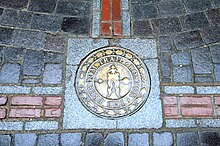Atlantic Northeast
Though no official boundary exists, the most common conception includes the Maritime provinces, southern Quebec, and the island of Newfoundland in Canada, and the New England region of the United States.
The variety of definitions can be attributed to overlapping commonalities of the region's history, culture, geography, ecology, society, and other factors.
The predominant nations in the region over the course of the estimated last 11,000 years have been the Abenaki, Penobscot, Mi'kmaq, Maliseet, and Passamaquoddy, all of whom were later associated with the Wabanaki Confederacy.
[1] These nations' countries mainly overlapped the soon-to-be Maritime provinces, such as Mi'kma'ki and Wolastokuk with New Brunswick, Nova Scotia, and Prince Edward Island, as well as Ndakinna, Peskotomuhkatik, and Pαnawαhpskewahki with Vermont, New Hampshire, and Massachusetts.
[4] During the period of the expulsion of the Acadians, thousands were deported from the present-day Canadian provinces of Nova Scotia, New Brunswick, and PEI, as well as from northern Maine — parts of the French region called Acadie — into the Thirteen Colonies, from 1755 until 1758.
Before 1860, about 30,000–40,000 black people entered Canada, many of them joining the previous group in Nova Scotia, either free or as escaped slaves through the Underground Railroad.
In 1979, both countries filed a joint application to the International Court of Justice to avoid having the dispute settled when oceanic boundaries in the area were set for mineral and fishing rights.
[9][10] Northeast Canyons and Seamounts Marine National Monument is located 150 miles (240 km) off the shore of Cape Cod.
[8] Acadia National Park is on Mount Desert Island in Maine, with 47,000 acres (19,000 ha) of woodlands, rocky shoreline, trails, camping, and wildlife.
[15] Most of the region's population is concentrated in southwestern New England and the Saint Lawrence Lowlands of Quebec, both of which form the northern part of their respective country's largest megalopolises.
[30] The Lake Champlain Maritime Museum, in Vergennes, Vermont, open from May to October, houses historic schooners, steamboats, wooden boats, shipwrecks, and even a Revolutionary War gunboat replica.
[31] In the Atlantic Northeast it is common to see many birds living in the region, including bald eagles (Haliaeetus leucocephalus), piping plovers (Atlantic coast) (Charadrius melodus), the red-cockaded woodpecker (Picoides borealis), the red knot (Calidris canutus rufa), the North American subspecies of the roseate tern (Sterna dougallii dougallii), and shorebirds.
The more common animals that are found in the area include the American eel (Anguilla rostrata), Appalachian monkey-face pearly mussel (Theliderma sparsa), dwarf wedgemussel (Alasmidonta heterodon), Atlantic horseshoe crab (Limulus polyphemus), Kenk's amphipod (Stygobromus kenki), and northern red-bellied cooter (Pseudemys rubriventris).





